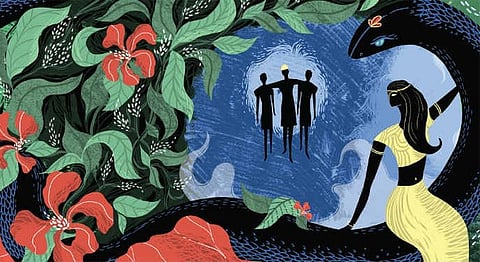
- #HGCREATORS
- #HGEXPLORE
- #HGVOICES
- #HGSHOP
- CAREERS
- ABOUT US
- CONTACT US

The Ramayana. A story that has versions transgressing 21 centuries. One whose lore has passed through time into all of Southeast Asia needs little introduction. This is a story we are all familiar with, in one way or another, right from the time we were children. Juggernaut, an Indian publishing company that aims to redefine the art of reading in this new digital age, is publishing an illustrated version of the Ramayana for Children. The book has been beautifully re-crafted by Arshia Sattar, who has dedicated the last 30 years to studying Valmiki’s original text of the Ramayana. But what really captured our attention were the illustrations of this timeless narrative by Bangalore-based artist Sonali Zohra. Homegrown caught up with the artist to understand the journey through this visual narrative and its adaptation suited for its audience.

It’s hard to imagine, especially with an epic as vast as the Ramayana, how an artist can pick one moment to freeze and capture the essence of a whole scene with vivid detail, let alone conceptualize illustrations for a whole book. Sonali found that the way in which the book had been written was so descriptive, all she had to do was read it over a few times and that it wasn’t really hard to visualise at all. “Juggernaut books had a list of the keys scenes in the book that they asked me to concentrate on and add any I wished would help the narrative. I sketched and read simultaneously. I referred to no other version of the Ramayana or any art related to the Ramayana. I wanted to be purely inspired by Arshia’s writing.”
For all the valour, respect and bravery in the story, there are equal measures of violence, fear and deception. The nature of the illustrations that depict the gravity of these large concepts is as important as ever, especially when in the hands of an 8-year-old. Wondering how much of the story changes when tell the tale is told to a child, Arshia Sattar eased our queries. “Actually, very little changes, I was surprised by that. The big change is the language — you use a smaller vocabulary to express the same ideas and tell the same story. With children, you end up not interpreting. More accurately, I should say that I didn’t interpret. I told the story in the most straightforward manner I could. Children will do with it as they please,” she said as reported on Mumbai Mirror.
At first glance, Sonali’s illustrations are far from what one usually finds in a children’s books. Her style is dark and detailed, with an obvious affinity for bright and rich tones. Taking us through the journey with the text and how it lends itself to translation, Sonal says “I loved reading mythological stories when I was a child. My favourite was the Mahabharata written by Shanta Rameshwar Rao and illustrated by the great Badri Narayan. I was inspired by this book, it made such a massive impression on me as a child. His illustrations are dark and detailed as well, they seemed to stick better than cute and “child-like” ones. I think children understand dark subjects well, they aren’t afraid till adults project their fears on them. I approached the illustrations based on the story and also what I would have liked to see as a kid.”
Ramayana For Children by Arshia Sattar has been published by Juggernaut Books and is available in bookstores and on their app.
[Scroll on to see the illustrations in Arshia Sattar’s Ramayana For Children]






Words: Tansha Vohra
